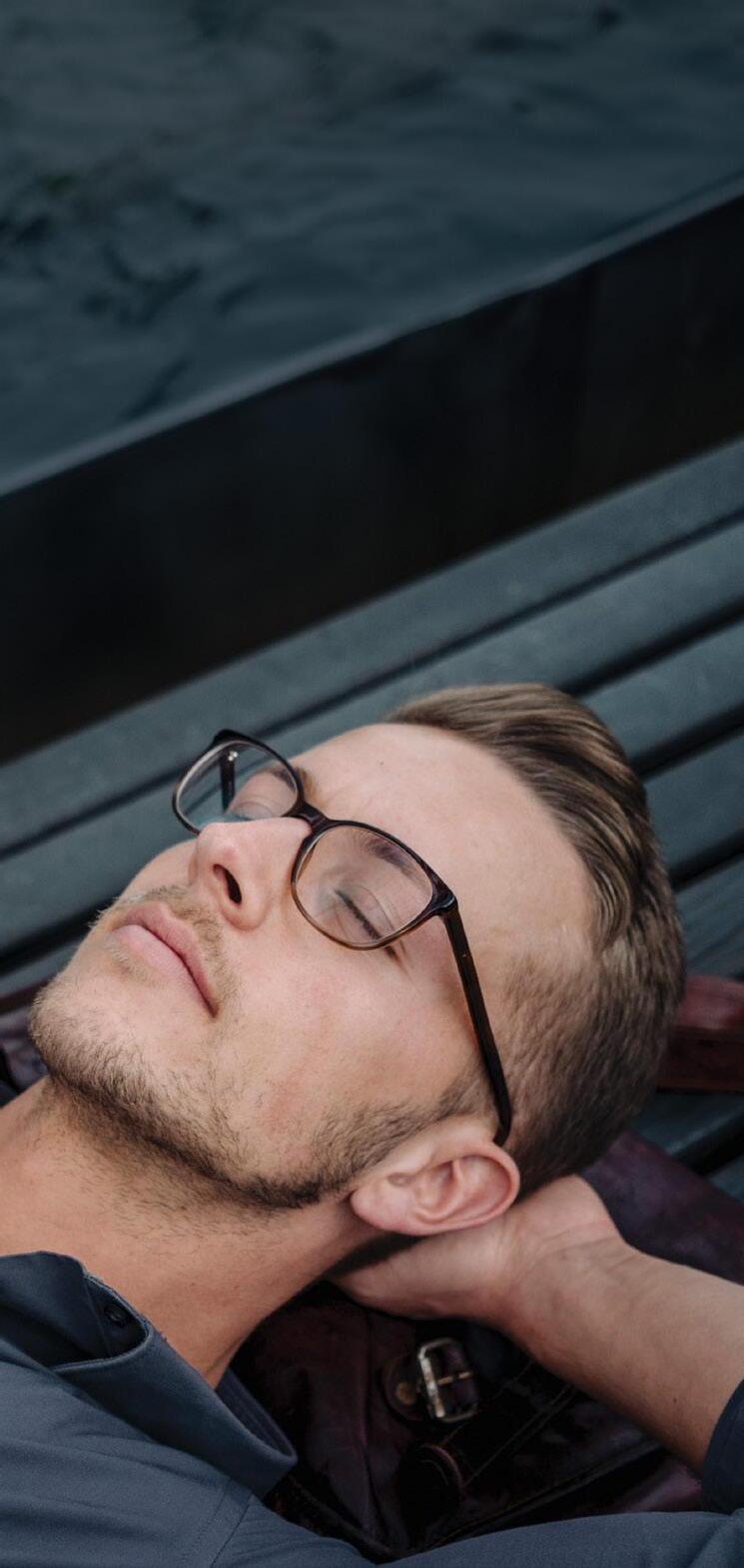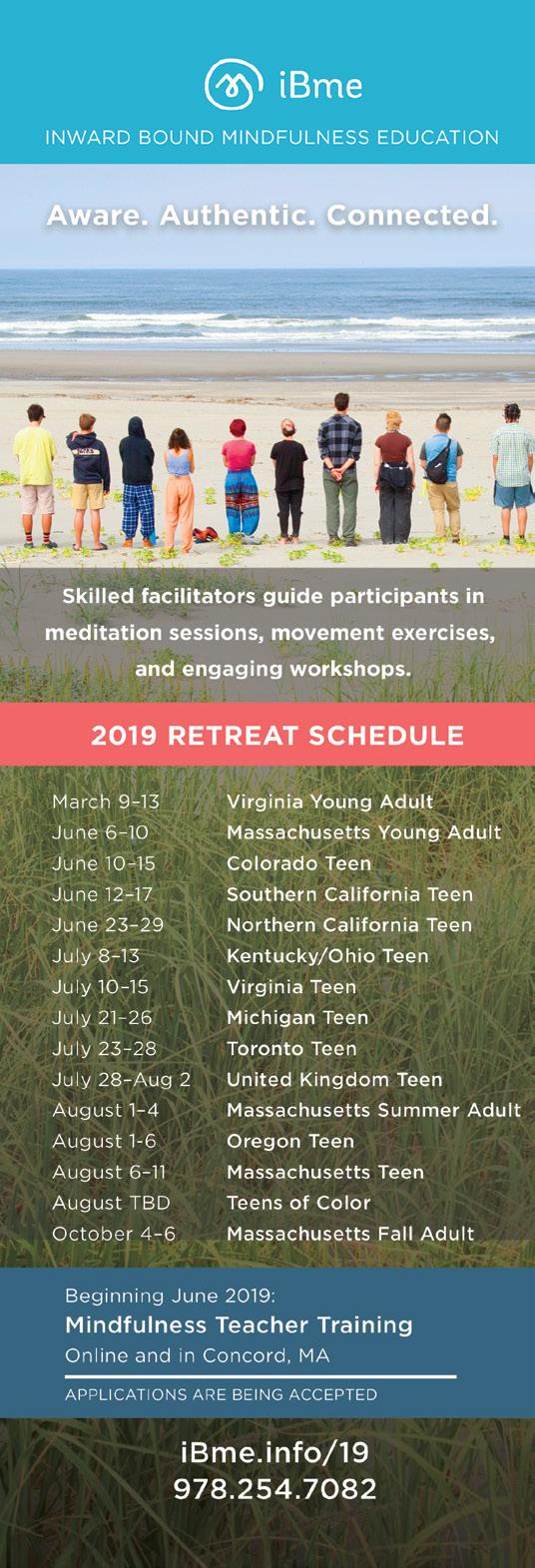
5 minute read
DISCOVER THE BODY UNIVERSE
rib cage in back, all the way up to the collarbones and shoulders.
From the shoulders, we move to the arms, usually doing them together, starting from the tips of the fingers and thumbs and moving successively through the fingers, the palms and backs of the hands, the wrists, forearms, elbows, upper arms, armpits, and shoulders again. Then we move into the neck and throat, and, finally, the face and head.
Advertisement
Along the way, we might tune in to some of the remarkable anatomical structures, biological functions, and more poetic, metaphorical, and emotional dimensions of the various regions of the body and each region’s particular individual history and potential: whether it is the ability of the feet to hold us up; the sexual and generative energies of the genitals; in women, the capacity to give birth and the memories of pregnancies and births for those who have had the experience; the eliminative and purifying functions associated with the bladder, kidneys, and bowels; the digestive fires of the abdomen and its role in breathing and in grounding us in the physical center of gravity of the body; the stresses and triumphs of the lower back in carrying us upright in the gravitational field; the radiant potential inherent in the solar plexus; the chest as the location of the metaphorical as well as the physical heart (we speak, for instance, of being lighthearted, heavyhearted, hard-hearted, brokenhearted, warmhearted, glad-hearted, and of “getting things off our chests”); the huge mobility of the shoulders; the beauty of the hands and arms; the remarkable structures and functions of the larynx, which allow us, in combination with the lungs and the tongue, the lips and the mouth, to express what is in our hearts and on our minds in speech and in song; how hard the face works to convey what we are feeling or hide what we are feeling, and the quiet dignity of the human face in repose; and the remarkable, ever-changing architecture and capacities of the human brain (the most complex arrangement of matter in the known-by-us universe, housed right under the vault of the cranium) and nervous system.
From Falling Awake: How to Practice Mindfulness in Everday Life, by Jon KabatZinn, published by Hachette. Copyright what is technically called proprioception, which Sacks calls “that vital sixth sense without which a body must remain unreal, unpossessed.” Christina had no muscle or tendon or joint sense whatsoever, and no words to describe her condition. Poignantly, in the same way that we see with people who lack sight or hearing, she could only use analogies derived from her other senses to describe her experiences. “I feel my body is blind and deaf to itself... It has no sense of itself.” In Sacks’s words, “she goes out when she can, she loves open cars, where she can feel the wind on her body and face (superficial sensation, light touch, is only slightly impaired).” “It’s wonderful,” she says. “I feel the wind on my arms and face, and then I know, faintly, I have arms and a face. It’s not the real thing, but it’s something—it lifts this horrible dead veil for a while.”
Lost Identity
Along with the loss of her sense of proprioception came the loss of what Sacks calls the fundamental mooring of identity—that embodied sense of being, of having a corporeal identity. “For Christina there is this general feeling—this ‘deficiency in the egoistic sentiment of individuality’— which has become less with accommodation, with the passage of time.”
Amazingly, she found her senses of sight and → mJon Kabat-Zinn expands on his definition of mindfulness in a video interview with Mindful.org. Plus— Follow his guided meditations for body awareness and loving-kindness. Visit mindful.org/JKZ hearing assisting her with reclaiming some degree of external control over the positioning of her body and its ability to vocalize, but all her movements have to be carried out with extreme deliberateness and conscious attention. All the same, “there is this specific, organically based, feeling of disembodiedness, which remains as severe, and uncanny, as the day she first felt it.” Unlike those who are paralyzed by transections high up in the spinal cord and who also lose proprioception, “Christina, though ‘bodiless,’ is up and about.”

Make no mistake about it. Just as the loss of knowing who you are in sufferers of Alzheimer’s disease is in no way some kind of shortcut to selflessness, the loss of this proprioceptive mooring is not liberating in any sense of the word. It is not enlightenment, nor a dissolving of ego, nor the letting go of an overwrought attachment to the body. It is a pathological, utterly destructive process that robs the individual of what Sacks calls “the start and basis of all knowledge and certainty,” quoting the philosopher Ludwig Wittgenstein. We have no words to describe the feelings we might be left with in the face of such a loss because the loss of the felt sense of the body, especially when the body can still move, is inconceivable to us.


From Oblivion To Body Awareness
“Those aspects of things that are most important for us are hidden because of their simplicity and familiarity. (One is unable to notice something because it is always before one’s eyes.) The real foundations of his enquiry do not strike a man at all.”
These are Wittgenstein’s words, with which Sacks opens his story about that “sixth sense” we so don’t know we have, so much is it in evidence, namely the felt sense of the body in space. It is so allied with our physicality, our physical “presence,” our sense of the body as proper to us and therefore as our own, that we fail to notice it or appreciate its centrality in our construction of the world and who we (think we) are. When we practice the body scan, our awareness includes that very sense of proprioception that Sacks is describing and that →
Christina tragically lost, the felt sense of having a body and, within the universe of the body as one seamless whole, the felt sense of all its various regions, which we can isolate in our minds to a degree, zero in on, and “inhabit.” When we practice the body scan, we are reclaiming the vibrancy of the body as it is from the cloud of unawareness that stems from its being taken for granted, so familiar is it to us. Without trying to change anything, we are investing it with our attention and therefore, with an embodied sense of appreciation and our love. We are explorers of this mysterious, ever-changing body-universe that simultaneously is us in such a profound way and isn’t us in an equally profound way.
Connecting To Your Core Being

And when some sort of healing is longed for and remains a possibility, however remote it might seem, a willingness to reclaim the body from the oblivion of taken-for-grantedness or from narcissistic self-obsession is paramount. Working at it every day, we reconnect with the very source of our humanity, with our elemental core of being.
When awareness embraces the senses it enlivens them. We have all felt that at times, moments of extraordinary vividness. In the case of proprioception, when we truly give ourselves over to listening to the body in a disciplined and loving way and persevere at it for days, weeks, months, and years as a discipline and a love affair in and of itself, even if we don’t hear much at first, there is no telling what might occur. But one thing is sure. As best it can, the body is listening back, and responding in its own mysterious and profoundly enlivening and illuminating ways. ●
From The Healing Power of Mindfulness: A New Way of Being , by Jon Kabat-Zinn, published by Hachette. Copyright © 2018 by Jon Kabat-Zinn







